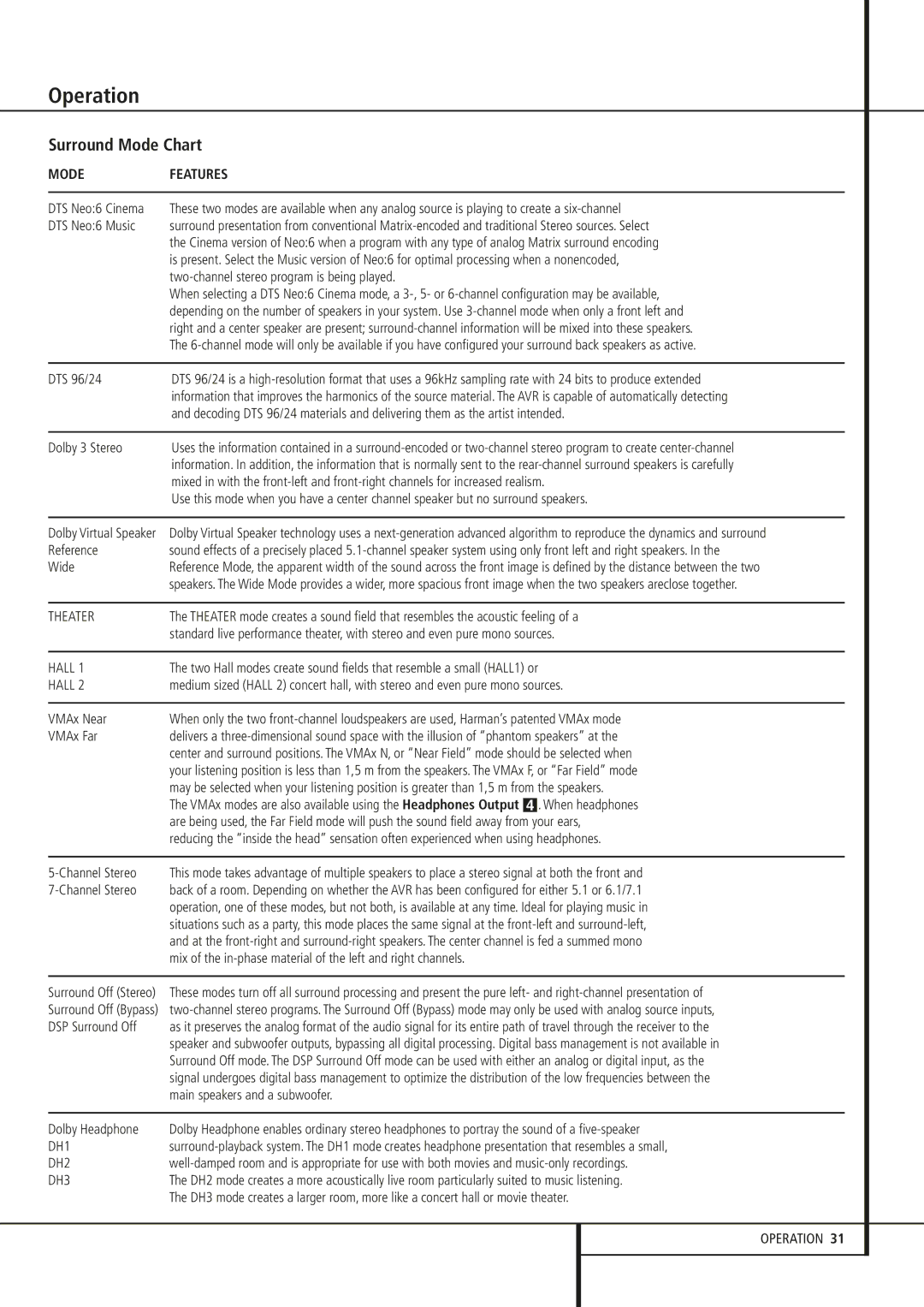
Operation
Surround Mode Chart
MODE | FEATURES |
|
|
DTS Neo:6 Cinema | These two modes are available when any analog source is playing to create a |
DTS Neo:6 Music | surround presentation from conventional |
| the Cinema version of Neo:6 when a program with any type of analog Matrix surround encoding |
| is present. Select the Music version of Neo:6 for optimal processing when a nonencoded, |
| |
| When selecting a DTS Neo:6 Cinema mode, a |
| depending on the number of speakers in your system. Use |
| right and a center speaker are present; |
| The |
|
|
DTS 96/24 | DTS 96/24 is a |
| information that improves the harmonics of the source material. The AVR is capable of automatically detecting |
| and decoding DTS 96/24 materials and delivering them as the artist intended. |
|
|
Dolby 3 Stereo | Uses the information contained in a |
| information. In addition, the information that is normally sent to the |
| mixed in with the |
| Use this mode when you have a center channel speaker but no surround speakers. |
|
|
Dolby Virtual Speaker | Dolby Virtual Speaker technology uses a |
Reference | sound effects of a precisely placed |
Wide | Reference Mode, the apparent width of the sound across the front image is defined by the distance between the two |
| speakers. The Wide Mode provides a wider, more spacious front image when the two speakers areclose together. |
|
|
THEATER | The THEATER mode creates a sound field that resembles the acoustic feeling of a |
| standard live performance theater, with stereo and even pure mono sources. |
|
|
HALL 1 | The two Hall modes create sound fields that resemble a small (HALL1) or |
HALL 2 | medium sized (HALL 2) concert hall, with stereo and even pure mono sources. |
|
|
VMAx Near | When only the two |
VMAx Far | delivers a |
| center and surround positions. The VMAx N, or “Near Field” mode should be selected when |
| your listening position is less than 1,5 m from the speakers. The VMAx F, or “Far Field” mode |
| may be selected when your listening position is greater than 1,5 m from the speakers. |
| The VMAx modes are also available using the Headphones Output 4. When headphones |
| are being used, the Far Field mode will push the sound field away from your ears, |
| reducing the “inside the head” sensation often experienced when using headphones. |
|
|
This mode takes advantage of multiple speakers to place a stereo signal at both the front and | |
back of a room. Depending on whether the AVR has been configured for either 5.1 or 6.1/7.1 | |
| operation, one of these modes, but not both, is available at any time. Ideal for playing music in |
| situations such as a party, this mode places the same signal at the |
| and at the |
| mix of the |
|
|
Surround Off (Stereo) | These modes turn off all surround processing and present the pure left- and |
Surround Off (Bypass) | |
DSP Surround Off | as it preserves the analog format of the audio signal for its entire path of travel through the receiver to the |
| speaker and subwoofer outputs, bypassing all digital processing. Digital bass management is not available in |
| Surround Off mode. The DSP Surround Off mode can be used with either an analog or digital input, as the |
| signal undergoes digital bass management to optimize the distribution of the low frequencies between the |
| main speakers and a subwoofer. |
|
|
Dolby Headphone | Dolby Headphone enables ordinary stereo headphones to portray the sound of a |
DH1 | |
DH2 | |
DH3 | The DH2 mode creates a more acoustically live room particularly suited to music listening. |
| The DH3 mode creates a larger room, more like a concert hall or movie theater. |
OPERATION 31
